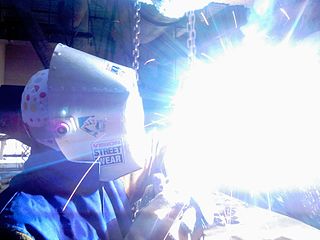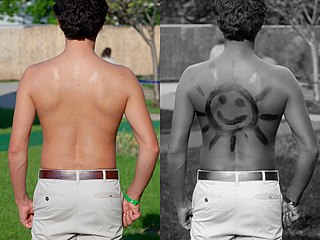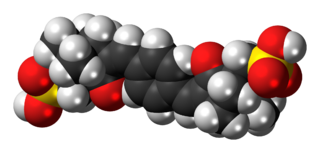
Ultraviolet (UV) light is electromagnetic radiation of wavelengths of 10–400 nanometers, shorter than that of visible light, but longer than X-rays. UV radiation is present in sunlight, and constitutes about 10% of the total electromagnetic radiation output from the Sun. It is also produced by electric arcs, Cherenkov radiation, and specialized lights, such as mercury-vapor lamps, tanning lamps, and black lights.

Sunscreen, also known as sunblock, sun lotion or sun cream, is a photoprotective topical product for the skin that helps protect against sunburn and prevent skin cancer. Sunscreens come as lotions, sprays, gels, foams, sticks, powders and other topical products. Sunscreens are common supplements to clothing, particularly sunglasses, sunhats and special sun protective clothing, and other forms of photoprotection.
4-Aminobenzoic acid (also known as para-aminobenzoic acid or PABA because the two functional groups are attached to the benzene ring across from one another in the para position) is an organic compound with the formula H2NC6H4CO2H. PABA is a white solid, although commercial samples can appear gray. It is slightly soluble in water. It consists of a benzene ring substituted with amino and carboxyl groups. The compound occurs extensively in the natural world.

Sunless tanning, also known as UV filled tanning, self tanning, spray tanning, or fake tanning, refers to the effect of a suntan without exposure to the Sun. Sunless tanning involves the use of oral agents (carotenids), or creams, lotions or sprays applied to the skin. Skin-applied products may be skin-reactive agents or temporary bronzers (colorants).

Ecamsule is an organic compound which is added to many sunscreens to filter out UVA rays. It is a benzylidene camphor derivative, many of which are known for their excellent photostability.

Avobenzone is an organic molecule and an oil-soluble ingredient used in sunscreen products to absorb the full spectrum of UVA rays.

Octyl methoxycinnamate or ethylhexyl methoxycinnamate (INCI) or octinoxate (USAN), trade names Eusolex 2292 and Uvinul MC80, is an organic compound that is an ingredient in some sunscreens and lip balms. It is an ester formed from methoxycinnamic acid and 2-ethylhexanol. It is a liquid that is insoluble in water.

UV filters are compounds, mixtures, or materials that block or absorb ultraviolet (UV) light. One of the major applications of UV filters is their use as sunscreens to protect skin from sunburn and other sun/UV related damage. After the invention of digital cameras changed the field of photography, UV filters have been used to coat glass discs fitted to camera lenses to protect hardware that is sensitive to UV light.

Octocrylene is an organic compound used as an ingredient in sunscreens and cosmetics. It is an ester formed by the Knoevenagel condensation of 2-ethylhexyl cyanoacetate with benzophenone. It is a viscous, oily liquid that is clear and colorless.

2-Ethylhexyl salicylate also known as octisalate or octyl salicylate, is an organic compound used as an ingredient in sunscreens and cosmetics to absorb UVB (ultraviolet) rays from the sun. It is an ester formed by the condensation of salicylic acid with 2-ethylhexanol. It is a colorless oily liquid with a slight floral odor.

Homosalate is an organic compound used in some sunscreens. It is made by the Fischer–Speier esterification of salicylic acid and 3,3,5-trimethylcyclohexanol, the latter being a hydrogenated derivative of isophorone. Contained in 45% of U.S. sunscreens, it is used as a chemical UV filter. The salicylic acid portion of the molecule absorbs ultraviolet rays with a wavelength from 295 nm to 315 nm, protecting the skin from sun damage. The hydrophobic trimethyl cyclohexyl group provides greasiness that prevents it from dissolving in water.

Bisoctrizole is a phenolic benzotriazole that is added to sunscreens to absorb UV rays. It is a broad-spectrum ultraviolet radiation absorber, absorbing UVB as well as UVA rays. It also reflects and scatters UV.

Pyrimidine dimers represent molecular lesions originating from thymine or cytosine bases within DNA, resulting from photochemical reactions. These lesions, commonly linked to direct DNA damage, are induced by ultraviolet light (UV), particularly UVC, result in the formation of covalent bonds between adjacent nitrogenous bases along the nucleotide chain near their carbon–carbon double bonds, the photo-coupled dimers are fluorescent. Such dimerization, which can also occur in double-stranded RNA (dsRNA) involving uracil or cytosine, leads to the creation of cyclobutane pyrimidine dimers (CPDs) and 6–4 photoproducts. These pre-mutagenic lesions modify the DNA helix structure, resulting in abnormal non-canonical base pairing and, consequently, adjacent thymines or cytosines in DNA will form a cyclobutane ring when joined together and cause a distortion in the DNA. This distortion prevents DNA replication and transcription mechanisms beyond the dimerization site.

Indirect DNA damage occurs when a UV-photon is absorbed in the human skin by a chromophore that does not have the ability to convert the energy into harmless heat very quickly. Molecules that do not have this ability have a long-lived excited state. This long lifetime leads to a high probability for reactions with other molecules—so-called bimolecular reactions. Melanin and DNA have extremely short excited state lifetimes in the range of a few femtoseconds (10−15s). The excited state lifetime of compounds used in sunscreens such as menthyl anthranilate, avobenzone or padimate O is 1,000 to 1,000,000 times longer than that of melanin, and therefore they may cause damage to living cells that come in contact with them.

Diethylamino hydroxybenzoyl hexyl benzoate (INCI) is an organic compound used in sunscreens to absorb UVA radiation. It is marketed as Parsol DHHB by DSM and as Uvinul A Plus by BASF. DHHB has an absorption maximum of 354 nm.

Iscotrizinol is an organic compound used in sunscreens to absorb UVB and some UVA radiation with a peak protection at 310 nm. It is one of the most photostable chemical sunscreens known today with 25 hours required to lose 10% of its SPF protection ability. It is marketed as Uvasorb HEB by 3V Sigma.
A Certified Organic Sunscreen, also known as Petrochemical-Free Sunscreen, is a third party certified sunscreen product consisting of certified and approved organic ingredients, with typically zinc oxide acting as the photo-protector. An organic sunscreen is verified and approved by a certifier to international or national organic standards, such as NSF/ANSI 305 and USDA organic, which define production and labelling requirements for personal care products containing organic ingredients. These standards are complemented by existing sunscreen regulatory bodies such as the FDA that regulate the efficacy of the sunscreen, safety and permitted ingredients. Generally speaking, sunscreen has photo-protective properties that reduce the risk of skin cancer and ageing with relation to the SPF value and proper application.
Z-Cote is a commercial zinc oxide line manufactured and owned by BASF. Due to Z-Cote's photo-protective properties it is commonly used in personal care products and sunscreens. It is available in nano, non-nano, coated and uncoated forms. Z-Cote is a derivative of zinc oxide which is Generally Recognized As Safe and Effective (GRASE) by the FDA as a nutrient, cosmetic colour additive, skin protection active ingredient and other OTC products. Manufactured zinc oxide, such as Z-Cote, is only recognised as GRASE by the FDA when it is compliant with the Good manufacturing practice (GMP) standard. The original Sunsmart and Submicro Encapsulation Technologies Z-Cote patent filed in 1991 for UV skin protection expired in 2015.
Methoxypropylamino cyclohexenylidene ethoxyethylcyanoacetate (INCI) is an organic compound used in sunscreens to absorb UVA radiation. It is marketed as Mexoryl 400 by L'Oréal. MCE has an absorption maximum of 385 nm, which is in the long-wave UVA range. Like Mexoryl SX (Ecamsule) and Mexoryl XL, it is used exclusively in products manufactured by L'Oréal. MCE was developed by L'Oréal and BASF.

Tris-biphenyl triazine (INCI) is an organic compound used in sunscreens to absorb UVA and UVB radiation. It is marketed as Tinosorb A2B by BASF. Tris-biphenyl triazine is considered a broad-spectrum UV absorber, covering the UVA2 and UVB range.
















